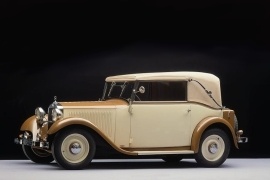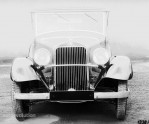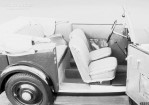Segment: Roadster & Convertible
Production years: 1932, 1933, 1934, 1935, 1936
 4 Photos
4 PhotosMercedes-Benz introduced the Typ 170 range in 1931 and helped the German carmaker survive the Great Depression.
After the Wall Street Crash in late 1929, the effects started to spread worldwide and struck Germany in the summer of 1931. Mercedes-Benz management took the bold move to develop a new, more affordable vehicle and launched it in October at the Paris Motor Show. France was one of the least affected countries by the Great Depression, and it was the right place to unveil a high-quality vehicle at a lower price.
Hans Nibel designed the light car to be affordable and dependable. The small vehicle featured slim and rounded fenders at the front, which supported a transverse chromed bar that kept the electric headlights. A flat and squared radiator surrounded by a chromed rim gave the vehicle an upscale look. After all, it wore the three-pointed star badge on the radiator's cap. In the convertible shape, the Typ 170 featured a flat windshield with two wipers at the top, with its folding roof retractable behind the rear seats. At the back, Mercedes installed a removable trunk, which was accessible from the outside. Starting with the 1934 model, it became attached to the body. Behind it, the carmaker installed the spare wheel.
The small vehicle provided room for four people inside, with two seats at the front and a bench in the rear. Its minimalist design kept the production cost low. Even though it didn't look like one of the flashy Mercedes cars, it provided some premium materials.
The 170 was an innovative vehicle that featured independent suspension in all corners, with swing axles in the rear and a transverse leaf-spring at the front. Its hydraulic braking system was another significant improvement. On top of that, very important for those times, it provided an anti-theft device that locked the steering column when the key was not in the ignition. Mercedes-Benz mated the inline-six engine to a three-speed manual transmission and a fourth overdrive gear for improved fuel efficiency.
MERCEDES BENZ Typ 170 Cabriolet C (W15) 1932, 1933, 1934, 1935, 1936
- 1.7
MERCEDES BENZ Typ 170 Cabriolet C (W15)
1.7
ENGINE SPECS - 1.7 | |
|---|---|
| Cylinders: | L6 |
| Displacement: | 1692 cm3 |
| Power: | 24 KW @ 3200 RPM 32 HP @ 3200 RPM 32 BHP @ 3200 RPM |
| Fuel System: | Carburetor |
| Fuel: | Gasoline |
PERFORMANCE SPECS | |
|---|---|
| Top Speed: | 56 mph (90 km/h) |
TRANSMISSION SPECS | |
|---|---|
| Drive Type: | Rear Wheel Drive |
| Gearbox: | Manual, 3 Speed |
BRAKES SPECS | |
|---|---|
| Front: | Drums |
| Rear: | Drums |
TIRES SPECS | |
|---|---|
| Tire Size: | 5.25-17 |
DIMENSIONS | |
|---|---|
| Length: | 159.8 in (4059 mm) |
| Width: | 64.2 in (1631 mm) |
| Height: | 65 in (1651 mm) |
| Front/rear Track: | 52.8/52.8 in (1,341/1,341 mm) |
| Wheelbase: | 102.4 in (2601 mm) |
WEIGHT SPECS | |
|---|---|
| Unladen Weight: | 2315 lbs (1050 kg) |
| Gross Weight Limit: | 3208 lbs (1455 kg) |
FUEL ECONOMY (NEDC) | |
|---|---|
| Combined: | 21.4 mpg US (11 L/100Km) |
| CO2 Emissions: | 262 g/km |



